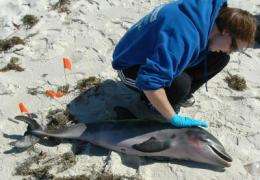Study points to causes of high dolphin deaths in Gulf of Mexico

The largest oil spill on open water to date and other environmental factors led to the historically high number of dolphin deaths in the Gulf of Mexico, concludes a two-year scientific study released today.
A team of biologists from several Gulf of Mexico institutions and the University of Central Florida in Orlando published their findings in the journal PLoS ONE.
For the past two years, scientists have been trying to figure out why there were a high number of dolphin deaths, part of what's called an "unusual mortality event" along the northern Gulf of Mexico.
Most troubling to scientists was the exceptionally high number of young dolphins that made up close to half of the 186 dolphins that washed ashore from Louisiana to western Florida from January to April 2010. The number of "perinatal" (near birth) dolphins stranded during this four-month period was six times higher than the average number of perinatal strandings in the region since 2003 and nearly double the historical percentage of all strandings.
"Unfortunately it was a 'perfect storm' that led to the dolphin deaths," said Graham Worthy, a UCF provosts distinguished professor of biology and co-author of the study. "The oil spill and cold winter of 2010 had already put significant stress on their food resources, resulting in poor body condition and depressed immune response. It appears the high volumes of cold freshwater coming from snowmelt water that pushed through Mobile Bay and Mississippi Sound in 2011 was the final blow."
The cold winter of 2010 was followed by the historic BP Deepwater Horizon disaster in April 2011, which dumped millions of gallons of oil into the Gulf of Mexico, likely disrupting the food chain. This was in the middle of the dolphins' breeding season. A sudden entry of high volumes of cold freshwater from Mobile Bay in 2011 imposed additional stress on the ecosystem and specifically on dolphins that were already in poor body condition.
"When we put the pieces together, it appears that the dolphins were likely weakened by depleted food resources, bacteria, or other factors as a result of the 2010 cold winter or oil spill, which made them susceptible to assault by the high volumes of cold freshwater coming from land in 2011 and resulted in distinct patterns in when and where they washed ashore," said Ruth Carmichael, a senior marine scientist at the Dauphin Island Sea Lab, an assistant professor of Marine Sciences at the University of South Alabama and the lead author of the study.
The majority of perinatal strandings were centered on the Mississippi-Alabama coast, adjacent to Mobile Bay, the 4th largest freshwater drainage in the U.S. The onshore movement of surface currents during the same period resulted in animals washing ashore along the stretch of coastline where freshwater discharge was most intense.
Others who contributed to the study include: William M. Graham and Stephan Howden from the University of Southern Mississippi, Stennis Space Center and Allen Aven from the Dauphin Island Sea Lab and the University of South Alabama.
Worthy is the Hubbs Professor of Marine Mammalogy. He received his PhD in 1986 from the University of Guelph in Canada and then completed post-doctoral training at the University of California at Santa Cruz, where he studied elephant seals, bottlenose dolphins and California sea lions. He spent 11 years as a faculty member in the Department of Marine Biology at Texas A&M University at Galveston and served as the State Coordinator for the Texas Marine Mammal Stranding Network.
Worthy and his team at UCF have been studying dolphin populations in the Pensacola and Choctawhatchee bays for years.
Journal information: PLoS ONE
Provided by University of Central Florida

















